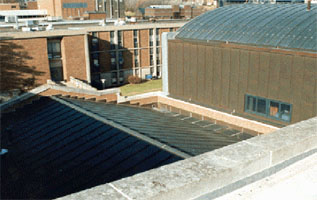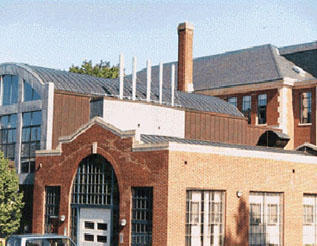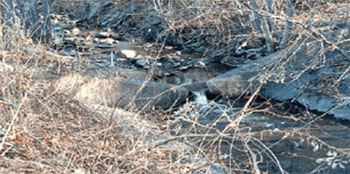New Research on Runoff from Copper Roofs
Copper Applications in Health & Environment
Introduction | Background | Some Objectives of the Project | Project Site | Project Methodology and Results
"The origins of copper...in storm waters are still poorly understood...we need to develop this information."
Sydney J. Holbrook
Former Commissioner Connecticut Department of Environmental Protection
In a letter to Dale Peters, CDA's Vice President - Environmental Programs.
Introduction
There is a lack of solid scientific research detailing how copper comes to be found in lakes, streams, and other bodies of water. The University of Connecticut, in collaboration with the International Copper Association Ltd, Copper Development Association Inc., and the Connecticut Department of Environmental Protection (Connecticut DEP) has undertaken a project that aims to fill in some of these gaps. In particular, the project hopes to increase the understanding of the extent to which copper runoff from architectural copper ends up in water sources.
Recently, the University of Connecticut issued the project's first annual report detailing some of the project's tentative results. Most importantly, the data indicate that as the rain runoff travels through the storm system's conveyance structures, the copper is chemically bound to organic matter and various anions. This, along with dilution, causes the copper to become largely inactive - or not bioavailable.
Background 
Many major rivers in Connecticut (a densely populated, highly industrial state) have copper levels that exceed Connecticut's Copper Water Quality Criteria. The Connecticut DEP is very interested understanding the sources and effects of the copper on aquatic life.
Studies completed by the Connecticut DEP have shown that elevated copper concentrations from waste water treatment plants (WWTP), due to the corrosion of household plumbing materials, do NOT pose a significant threat to aquatic life. Copper in WWTP effluent is strongly bound to organics and inorganics present in the wastewater, which minimizes copper's role in aquatic toxicity.
Given the above, the Connecticut DEP has turned its attention to other possible sources of copper, in particular runoff from copper roofing and gutters. In order to assist the DEP the copper industry - through ICA and CDA - has provided funding and technical assistance to the project.
Some Objectives of the Project 
- Track copper in storm water runoff from its sources to the receiving stream and determine the contribution from copper use in architectural applications.
- Develop a mathematical model to simulate the movement and final fate of copper from the time rain falls on a copper roof to the time it reaches the receiving stream.
- Determine the contribution of various sources of copper to any observed toxicity.
Project Site 
The project is located at the University of Connecticut campus. Only one building on campus contains a large amount of copper architectural material. This building has 11,921 square feet of copper roofing, as well as copper gutters, and decorative flashing. Currently, 2583 square feet of the roof is being closely monitored and sampled to determine the copper flux directly off the roof. The campus watershed also contains parking lots, atmospheric deposition collectors, a weir (a small dam which controls water flow), and an air particle filtering station. It also has a well-understood storm water system.

 University of Connecticut Buildings with Copper Roofs
University of Connecticut Buildings with Copper RoofsProject Methodology and Results 
Fifteen rainfall events are sampled each year of the study. During these 15 events, water samples are taken automatically at each of a number of sampling points. This study is designed to show what happens to dissolved copper concentrations and storm water toxicity at each at each point along the storm water system, from the beginning at the copper roof to the end at the system's outlet.
Water samples from a sampling station on a grassy area in a dormitory quadrangle known as "North Campus", show very little copper - apparently the tiny amount detected comes from wet and dry atmospheric deposition. Toxicity testing at this station shows no toxicity. On the other hand, storm water collected from the campus police station parking area shows a higher copper level that displays toxicity. The extensive copper roof of a large laboratory building sampled at the bottom of a leader in a ground floor laboratory, sheds higher copper levels. As expected, water samples taken from this station display toxicity.
 The Weir
The WeirThe important finding is that a few hundred yards away, at the outlet of the storm water system, there is absolutely no copper toxicity. In the short distance from the roof through the piping to the outlet, the copper is chemically bound to organic matter and various anions. This mechanism combined with dilution, renders the copper totally inactive - or not bioavailable.
Also in this Issue:
- New Research on Runoff from Copper Roofs
